|
The
title of this illustration was "A Blindfold Chess Contest by Mr.
Blackburne." The elucidation in The Illustrated Sporting and
Dramatic News (September 28, 1889) was: "Our sketch gives a
representation of the manner in which this blindfold performer plays his
game, being entirely shut away from his opponents by a dense mass of
onlookers who throng round the tables. We also give portraits of Mr.
Ford, who acted as teller, and of Mr. Adamson, the hon. secretary of the
City of London Chess Club, besides a portrait of Mr. Blackburne when not
playing." It may be noticed that the portrait of George Adamson is
the same as in the drawing of 1881 (See our contribution of January
2015: "The City Club's First Class Had a Busy 1881").
.
Blackburne
Blindfolded at the City Club (3)
.
The
picture above is of Blackburne's blindfold exhibition at the City of
London Chess Club in 1889. The date of the meeting was September 16, and
the place where Blackburne displayed his skills was the Salutation Inn,
17 Newgate Street. The Illustrated Sporting and Dramatic News of
September 28, 1889, commented (the picture was published in this paper):
Our
sketch gives a representation of the manner in which the blindfold
performer plays his game, being entirely shut away from his opponents by
a dense mass of onlookers who throng round the tables.
Blackburne,
who had returned from a visit to the United States and Canada, opposed
eight players on this occasion. He won five games and drew three. The
exhibition, the opening of the club's season, was well-attended. Again The
Illustrated Sporting and Dramatic News of September 21, 1889:
The
room was densely crowded by a brilliant assemblage of chess players,
including a considerable number of ladies, and nearly all the chairs in
the room were utilised to give vantage ground to an outer ring of
spectators.
Further
details of the meeting are:1
|
Result
+5 =3 -0; score 81.3 percent; playing hours 6.00 p.m.
— 11.30 p.m.
|
|
Opponents:
|
|
1
|
Blackburne
— Sugden
|
1-0
|
|
5
|
Blackburne
— Watson
|
1-0
|
|
2
|
Blackburne
— Bradford
|
1-0
|
|
6
|
Blackburne
— Pilkington
|
½-½
|
|
3
|
Blackburne
— Brown
|
1-0
|
|
7
|
Blackburne
— Hunt
|
1-0
|
|
4
|
Blackburne
— Latham
|
½-½
|
|
8
|
Blackburne
— Trenner
|
½-½
|
There
was an adjournment at 9.30 p.m.
for rest and relaxation which took about thirty minutes. The first game
had come to an end much sooner, at 8 o'clock.2 It is the only
encounter found of this meeting.
Joseph
H. Blackburne - A.E. Hunt
-
City
of London Chess Club, Blindfold Exhibition
-
London,
September 16, 1889, board 7
-
C52
Evans Gambit
1.
e4 e5 2. Nf3 Nc6 3. Bc4 Bc5 4. b4 Bxb4 5. c3 Ba5 6. d4 exd4 7. 0—0
dxc3 8. Qb3 Qf6 9. e5 Qg6 10. Nxc3 Bxc3
All
authorities agree now that the exchange of the bishop for the knight is
disadvantageous in this position, albeit Black is two pawns ahead.
11.
Qxc3 Nge7 12. Ng5
This
is, we believe, a novelty and a very noteworthy one, for it seems to
give White a more immediately pressing attack than 12 Ba3, followed by
Rad1, which used to be favored by old masters at this juncture.
12.
... 0—0
If
12. ... Nd8, White could also institute a strong attack by 13. f4.
13.
Bd3 f5
Black
drops into a finely conceived trap which the astute blindfold master has
laid for him. 13. ... Qh6 was the only proper move, and after 14. Bxh7+
Kh8 15. f4 d5 Black could depend on his majority of pawns on the queen's
side to make an impression, whereas White's attack on the other wing
would not amount to much.
14.
exf6
The
sans voir player evidently sees his way clear.
14.
... Qxf6 15. Bxh7+ Kh8 16. Qh3
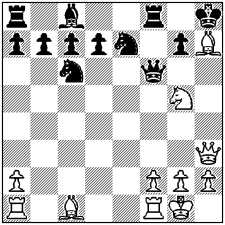
A
powerful and finishing stroke. Black resigns, for if 16. ... Qh6, then
evidently 17. Nf7+, winning the queen. In reply, however, to 16. ... d5
it should be noticed that 17. Qh4 is White's best play and is sufficient
to win. But should White impetuously answer 17. Bf5+, he would only gain
the queen for three minor pieces, which would enable the opponent to
make a very good fight, especially as he has three passed pawns on the
queen's side, thus: 17. Bf5+ Qh6 18. Nf7+ Rxf7 19. Bxh6 Bxf5, etc.
Sources:
Daily News, September 17, 1889; The
Chess Player's Chronicle, September 21, 1889; Manchester Evening News, September 21, 1889; Leeds Mercury, September 28, 1889; The Morning Post, September 30, 1889; The Illustrated Sporting
and Dramatic News, October 5, 1889; Nottinghamshire Guardian, October 5, 1889; The International Chess Magazine, October 1889, page 314 (notes by
Wilhelm Steinitz*); Birmingham
Weekly Mercury, November 2, 1889; Ladies'
Treasury, December 1, 1889.
Blackburne's twelfth
blindfold performance at the City of London Chess Club (the eleven
preceding matches are discussed in our articles of February and April
2014) took place on September 27, 1882. Once more, Blackburne opposed
eight members of the club at Mouflet's Hotel. The
Field (September 30, 1882):
On
Wednesday last, the rooms of the City of London Chess Club were again
crowded to suffocation by members and visitors, who are always eager to
be present at a feat of mental effort which can only be appreciated to
its full merit by eyewitnesses.
According
to The Times (September 28,
1882), the team of eight players that Blackburne opposed was the
strongest he had played in London, "none of his opponents being under
what is technically called "pawn and two" strength."
Leopold
Hoffer wrote in The Field
(September 30, 1882) that Blackburne had never before played with such
ease and rapidity: "We have been present very often when Mr.
Blackburne gave similar exhibitions; but never has he played with more
ease and with such rapidity as this time. Several mates in two and three
moves were announced to his surprised opponents, and he missed a mate in
eight moves, by touching mentally — if we may be permitted to use the
expression — the wrong peace."
All
leading members of the club and nearly all the foremost players of
London were present.3 Frank Healey and Frederick W. Lord
acted as tellers.
The
characteristics of the 1882 exhibition are:4
|
Result
+6 =2 -0; score 87.5 percent; playing hours 5.40 p.m.
— 9.45 p.m.
|
|
Opponents:
|
|
1
|
Blackburne
— Wilson
|
1-0
|
|
5
|
Blackburne
— Down
|
1-0
|
|
2
|
Blackburne
— Chappell
|
½-½
|
|
6
|
Blackburne
— Murray
|
1-0
|
|
3
|
Blackburne
— Cutler
|
1-0
|
|
7
|
Blackburne
— Stevens
|
1-0
|
|
4
|
Blackburne
— Herzfeld
|
1-0
|
|
8
|
Blackburne
— Vyse
|
½-½
|
The
progress of the evening was as follows: at 7.20 p.m.
Herzfeld was mated in two moves. Twenty minutes afterwards Chappell
agreed to draw. At 8.05 p.m.
Murray was mated in three moves, and at 8.34 p.m.
Down resigned. At 9.05 p.m.
Vyse accepted a draw, and at 9.25 p.m.
Stevens resigned. Ten minutes later Cutler resigned, and at 9.45 p.m.
Wilson followed his example.5
No
games of this performance have been found.
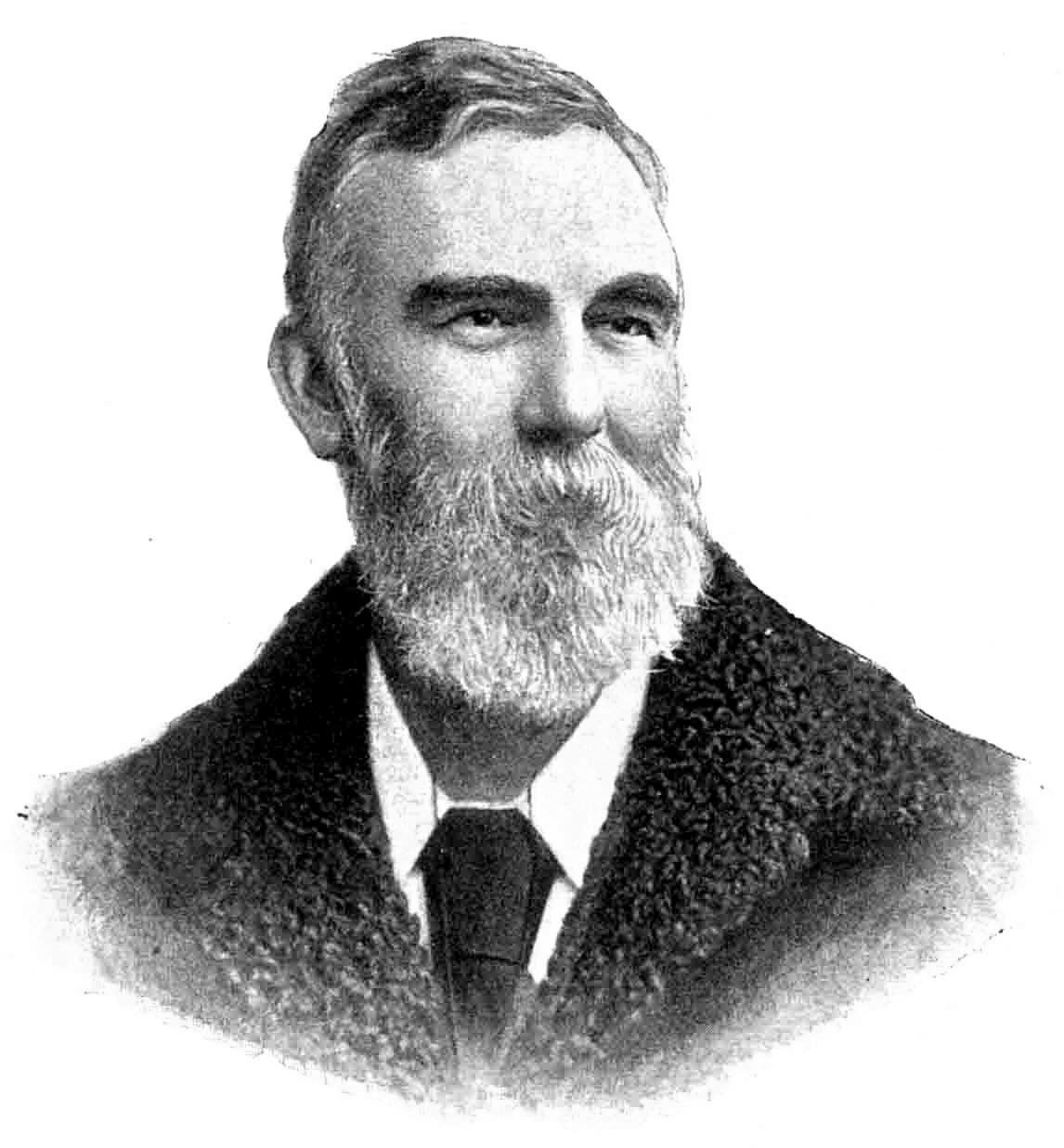
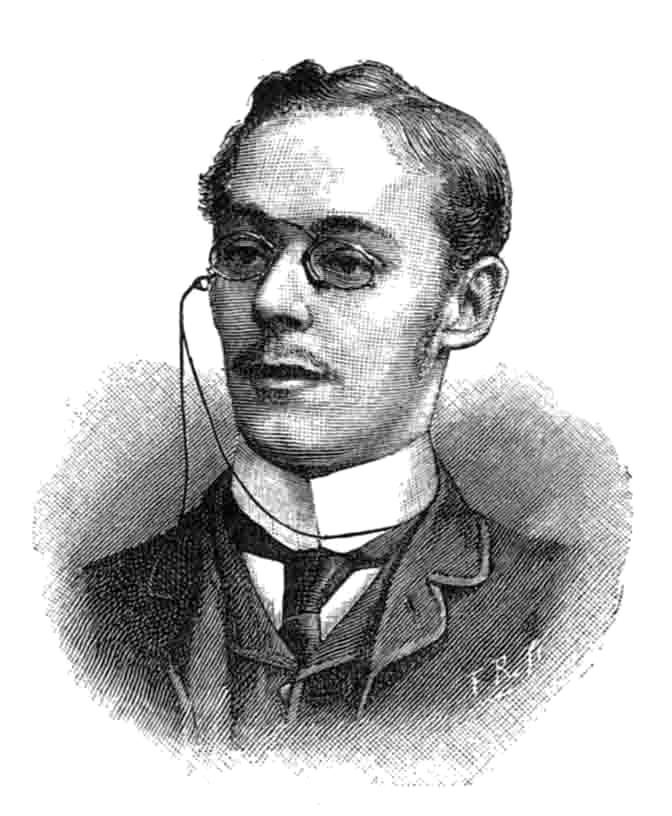 Alexander
S. Beaumont, Benjamin G. Laws
Alexander
S. Beaumont, Benjamin G. Laws
In
next year's exhibition, played on October 10, 1883, at Mouflet's
Hotel, Blackburne was again opposed by eight players. The highlights of this
year's entertainment are:6
|
Result
+4 =3 -1; score 68.8 percent; playing hours 6.00 p.m.
— 11.05 p.m.
|
|
Opponents:
|
|
1
|
Blackburne
— Gastineau
|
1-0
|
|
5
|
Blackburne
— Laws
|
0-1
|
|
2
|
Blackburne
— Beaumont
|
1-0
|
|
6
|
Blackburne
— Lee
|
½-½
|
|
3
|
Blackburne
— Scargill
|
½-½
|
|
7
|
Blackburne
— Tudor
|
½-½
|
|
4
|
Blackburne
— Wells
|
1-0
|
|
8
|
Blackburne
— Ridpath
|
1-0
|
The
course of the evening was given in The
Morning Post of October 11, 1883:
Play
commenced punctually at six o'clock, when Mr. Blackburne, who was
seated at the end of the room and out of sight of the boards, announced
the opening move P-K4 on every board. Mr. Lord acted as teller, and
called out the replies of the eight opponents, taking the boards in
their order. The developing moves were soon made. Messrs. Gastineau,
Laws, and Ridpath played the French defence, Captain Beaumont and Mr.
Wells irregular openings, Messrs. Scargill and Tudor declined the
King's Gambit by B-B4, and Mr. Lee the Four Knights' Game. For two
hours the games progressed rapidly. Mr. Gastineau was soon in
difficulties, the blindfold player attacking him in the most vigorous
manner on the king's side. Mr. Wells lost two pawns and the other
games seemed pretty equal, most interest being displayed in those of
Messrs. Laws and Lee, who were making a capital fight. At 8.20 a round
of applause greeted Mr. Blackburne as he announced mate in two moves on
Mr. Gastineau's board. The next game was not finished till nine, when
Mr. Blackburne proposed, and Mr. Scargill accepted, a draw. Mr. Lee soon
after agreed to a like result, and about ten Mr. Wells resigned.
Meanwhile Mr. Laws had obtained a decided advantage, having won two
pawns and exchanged queens. This was the only game in which the
blindfold player had the worst of it. In those of Captain Beaumont and
Mr. Ridpath he had a winning superiority, both in force and position.
Mr. Tudor's game had the appearance of a draw.
Land
and Water
(October 20, 1883) reported an incident. A spectator charged one of the
players of consulting. Editor Willian N. Potter wrote: "All
consultation is decidedly unfair towards a blindfold performer; but
sometimes advice not sought is officiously given."
Lord
acted as teller. Two games of this exhibition have been discovered.
Joseph
H. Blackburne — Alexander S. Beaumont
-
City
of London Chess Club, Blindfold Exhibition
-
London,
October 10, 1883, board 2
-
C44
King's Pawn Game
1.
e4 e5 2. Nf3 Nc6 3. Bc4 d6 4. d4 exd4 5. c3
Threatening
6. Qb3, etc., in case Black should make any other developing move than
the one in the text.
5.
... Be6 6. Bxe6 fxe6 7. Qb3 Qc8 8. Nxd4
8.
cxd4 seems better. Mr. Blackburne admits that, in a game over the board,
he would have done it. 8. Ng5, although tempting, does not answer
satisfactorily upon examination, because of 8. ... dxc3 9. Nxc3 Nd8,
etc.
8.
... Nxd4 9. cxd4 Ne7 10. Nc3 g6 11. Be3 Bg7 12. Rc1 a6 13. 0—0 0—0
14. f4 Kh8 15. Ne2 c6 16. Ng3 Qd7 17. Qd1 Rf7
Black's
weak point is the pawn at e6, which must be guarded by the queen.
White's 17. Qd1 is suggestive of 18. Qg4, keeping the pressure upon the
king's pawn. It would, therefore, have been better for Black to play 17.
... Rad8, defending the queen, so as to enable him to advance the king's
pawn.
18.
Qg4 Raf8 19. Rfd1 Bh6
We
should have preferred 19. ... Ng8, followed by pawn to d5 and Knight to
e7 or h6 accordingly.
20.
Ne2 d5 21. Qh3 Bg7
Even
now the knight might have retired to g8: White would have probably
advanced 22. e5 and 23. g4, which could have been met with 23. ... g5
24. fxg5 Rf3 25. Ng3 Rxe3 26. gxh6 Qc7 27. Rf1 Rf3, and, after a series
of exchanges, Black would have remained with even pawns and a safe game.
22.
e5 Nf5 23. g4 Ne7 24. Rf1 Kg8 25. Kh1 Bh8
At
this stage Capt. Beaumont proposed a draw, but Mr. Blackburne declined
the offer. This may account for Black's next few moves, which were made
simply with the object of keeping the position such as it is, leaving it
for White to take the offensive, which he did.
26.
Ng1 Bg7 27. Nf3 h6 28. Nh4 Kh7 29. Rg1 Qd8
This
and the subsequent queen's moves are quite ineffective. It would have
been better to leave the queen at d7, so as to prevent the advance of
the king's bishop's pawn as long as possible.
30.
Rg3 Qb6 31. Qg2 Qb5 32. Rg1
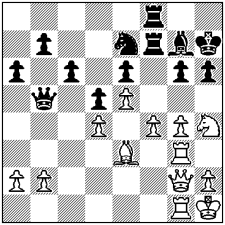
32.
... Rxf4
Black's
position is now hopeless. 33. f5 threatens the loss of a piece, so Black
gave up the exchange, choosing the lesser evil.
33.
Bxf4 Rxf4 34. Rf3 Rxd4 35. Rf7 Qc5 36. Qf2 Ng8 37. Rf1 Rc4 38. Rxg7+
Kxg7 39. Qf7+ Kh8 40. Nxg6,
mate.
Mr.
Blackburne's play throughout the game, but especially the ending, is
quite beyond praise.
Source:
The Field, October 20, 1883 (notes by Leopold Hoffer*).
Joseph
H. Blackburne — Benjamin G. Laws
-
City
of London Chess Club, Blindfold Exhibition
-
London,
October 10, 1883, board 5
-
C14
French Defense, Classical Variation
1.
e4 e6 2. d4 d5 3. Nc3 Nf6 4. Bg5
This
continuation is indefensible on theory, in consequence of the power
vested in Black's bishops after the knight is taken.
4.
... Be7 5. Bxf6 Bxf6 6. Nf3 Be7 7. exd5 exd5 8. Bd3 Be6 9. 0—0 Nd7 10.
Re1 c6 11. Ne2 Qc7
Without
pinning absolute approval to Mr. Laws' previous line of play, we may
concede that he has the better game of the two.
12.
Ng3
Pawn
to c3 would be our choice, and we also consider that queen to d2 is
better than the text move, though we acknowledge certain objections.
12.
... g6
The
correct reply, and it is a move that may often be played in the French
Defense, when the adverse queen's knight has come to g3, the reason
being that whatever weakness is thus introduced is counterbalanced by
the time required to get that knight into play afterwards.
13.
Ne5
Queen
to d2 is the best line now, undoubtedly.
13.
... Bd6 14. f4 0—0—0 15. c3 Rde8 16. b4
Hereby
giving up a pawn, which loss could be avoided by Ne2, though we must
allow that the game thus brought about is not one to be relished by
anyone, nor would it be suited to Mr. Blackburne's style any more than
to his taste.
16.
... f6 17. Nxd7 Bxd7 18. Qf3 Bxf4 19. Nf1 f5 20. b5 Bd6 21. a4 Rxe1 22.
Rxe1 Re8 23. Rxe8+
Best,
perhaps, in a theoretical sense; but such considerations have not much
to do with a game already lost upon theory. Retaining the rook would
give a better chance, we imagine.
23.
... Bxe8 24. g3 Qa5 25. Qe2 Bd7 26. bxc6 bxc6 27. Qc2 c5
This
bold line inflicts a deep wound on White's game. Some other skilful
moves have been from time to time made by Mr. Laws.
28.
Qa2 Qxc3 29. Ba6+ Kc7 30. Qxd5
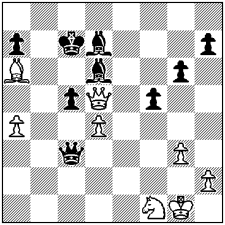
28.
... Bc6
At
once a saving clause and a winning stroke.
31.
Qc4
31.
Qf7+ Kb6 32. d5 is of course worthless, on account of Qd4+.
31.
... Qxd4+ 32. Qxd4 cxd4 33. a5 Bb4 34. Bd3 Bxa5 35. Kf2 Bc3 36. Ke2 a5
37. Nd2 a4 38. Nb1 Bb4 39. Bc4 Be4 40. Nd2 Bc2 41. Bg8 a3 42. Ba2 Kc6
43. Nf3 Bc3 44. h4 Kc5 45. Ne5 h5 46. Nxg6
Nd3+
would prolong the struggle, but the game is lost any way.
46.
... d3+ 47. Ke3 d2
White
resigns.
Source:
Land and Water, October 27, 1883 (notes by William N. Potter).
No
exhibition took place in 1884, because of Blackburne's health problems.
He suffered from bronchitis. The City of London Chess Club moved in 1884
from Mouflet's Hotel to the Salutation Inn at 17 Newgate Street,
nearby the old premises.
The
1885 performance occurred on October 16. The number of opponents was the
standard eight and several masters were present at the Salutation Inn
this day, amongst them Johannes H. Zukertort and George A. MacDonnell.
The latter wrote about his visit:7
As
soon as I entered the room I had the pleasure of seeing at the same
table Mr. Gastineau, Mr. F.H. Lewis, Mr. J.A. Manning, and other
favourites of the club. Being invited to join them I sat down, and away
we chatted and joked and laughed, whereupon a stern-looking youth
rebuked our levity and requested us not to disturb Mr. Blackburne.
Little did that youth know that no kind of human noise disturbs
Blackburne when "playing blindfold." On the contrary — as the
champion assured me after the performance — he likes at such times to
hear the hum of voices and the rattle of pleasantry.
Play
commenced at 5.30 p.m., and
the first game was concluded at 8.45 p.m.,
when J.H. Taylor resigned. The next game was completed at 9.56 p.m.;
H. Lawson hauled down his colors at that moment. The other games were
then quickly brought to an end.8
Lord
acted
anew as teller. Amongst
the spectators were Hoffer, MacDonnell and Zukertort.
Further
details of Blackburne's doings are:9
|
Result
+4 =3 -1; score 68.8 percent; playing hours 5.30 p.m.
— 11.30 p.m.
|
|
Opponents:
|
|
1
|
Blackburne
— Wainwright
|
0-1
|
|
5
|
Blackburne
— Lawson
|
1-0
|
|
2
|
Blackburne
— Taylor
|
1-0
|
|
6
|
Blackburne
— Watson
|
½-½
|
|
3
|
Blackburne
— Wilson
|
1-0
|
|
7
|
Blackburne
— Sumner
|
1-0
|
|
4
|
Blackburne
— Hamburger
|
½-½
|
|
8
|
Blackburne
— Lowe
|
½-½
|
Two
games of the 1885 exhibition have been discovered.
Joseph
H. Blackburne — J.H. Taylor
1.
e4 e5 2. f4 exf4 3. Nf3 g5 4. h4 g4 5. Ne5 h5
This
defense is now rarely adopted, and it has been justly superseded by that
of Paulsen which usually proceeds thus: 5. ... Nf6 6. Bc4 d5 7. exd5 Bg7
8. d4 0—0; and if 9. 0—0, then 9. ... Nxd5, or if 9. Nc3, then 9.
... Nh5, and as far as practical experience has shown up to the present,
especially in a game of the match between Steinitz and Zukertort, in
1872, and in a game between the same players in the Vienna Tournament of
1882, the defense appears to have the best of the position in either
case.
6.
Bc4 Rh7 7. d4 d6 8. Nxf7
A
mode of attack sanctioned by most authorities and one suitable to Mr.
Blackburne's dashing style. But we deliberately prefer the retreat of
Nd3, for we think that by proper play, difficult as it may be, the
defense ought to be able effectually to guard all center points against
the hostile attack and should retain the two minor pieces against rook
and pawn with the superior game.
8.
... Rxf7 9. Bxf7+ Kxf7 10. Bxf4 Bg7
His
game is practically lost from this point though the move in the text
looks good enough at first sight. The bishop, however, is now only in
the way, for, we believe, the post he occupies is the best place for the
Black king who ought to be removed there at once. The general plan of
the defense ought then to be to develop the pieces on the queen's side,
while the minor pieces on the king's side might well be left at home for
a few moves at least. For instance, 10. ... Kg7 11. Nc3 (or 11. 0—0
Qxh4, etc.) 11. ... c6 12. Qd3 Nd7, followed mostly by Nb6, with a good
game.
11.
0—0 Nf6
If
Ke8, the only other feasible defense, White could reply Qd3, threatening
Qg5, and winning the king's rook's pawn with a check , besides also
threatening pawn to e5, followed by Qg6+.
12.
Nc3 Kg8 13. Bg5 Be6 14. e5
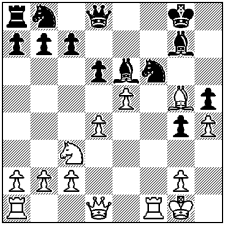
All
in admirable style, considering especially that he conducts seven other
games at the time without seeing the board.
14.
... dxe5 15. Ne4 Nc6 16. c3
Simple
enough when you see it, but it is a move which bears internal evidence
that the performer who did not see it, excepting in his mind's eye, must
have looked far ahead.
16.
... exd4
If,
for instance, Black had here sacrificed the queen, it required some neat
play to prove a speedy and sure win, e.g.,
16. ... Nxe4 17. Bxd8 Rxd8 18. Qd3 Nd6 (if
18. ... Nf6 19. Rxf6
Bxf6 20. Qg6+, etc.) 19.
Qg6 Bf7 20. Rxf7 (best) 20. ... Nxf7 21. d5 (best) 21. ... Rxd5 22. Rf1
Ncd8 23. Qxh5, and after winning the knight's pawn, his two passed pawns
on the king's side would win without much difficulty.
17.
Nxf6+ Bxf6 18. Rxf6
Resigns.
He cannot save the game, and the following is a probable continuation:
18. ... Qd7 19. Qd3 Ne7 20. Rg6+ Nxg6 21. Qxg6+, and wins.
Sources:
The International Chess Magazine, December 1885, page 368 (notes by
Wilhelm Steinitz*); The
Illustrated Sporting and Dramatic News, April 10, 1886.
Joseph
H. Blackburne — H. Lawson
1.
e4 e6 2. d4 d5 3. Nc3 Nc6
As
stated on previous occasions, Nf6 is here the correct play.
4.
Nf3 Bb4 5. e5
Not
as good as Bd3. If Black then answer Nf6, White may pin that knight by
Bg5 with advantage.
5.
... Nge7 6. Bd3 Nf5 7. Bxf5 exf5 8. 0—0 0—0
Black
could have obtained here slightly the better position by Bxc3, followed
by either Na5 or Be6, for White's doubled pawns on the queen's side,
were a greater source of weakness than Black's doubled pawns on the
king's wing.
9.
Ne2 Ne7 10. c3 Ba5 11. Bg5 Qe8 12. Nf4 h6
Perhaps
he may have concluded that the sacrifice of the pawn was his best
resource against the threatened attack by Nh5, but he had in reality
nothing to fear from that move, e.g.,
12. ... c6 13. Nh5 f6 14. exf6 (or
14. Bxf6 Qxh5 15. Bxe7
Rf7, followed by pawn to f4, with a good game)
14. ... Qxh5 15. fxe7 Re8 16. Re1 Bc7, followed by Bd6, and
afterwards recovering the pawn with an even game.
13.
Bxe7 Qxe7 14. Nxd5 Qd8 15. Nf4 c6 16. Re1 Bc7 17. e6
Energetic
and excellent. He threatens pawn to e7, and the exchange of pieces is,
of course, in his favor with a pawn ahead.
17.
... fxe6 18. Nxe6 Bxe6 19. Rxe6 Qd7 20. Qe2 Rae8 21. Re1 Kf7 22. Ng5+
A
fine stroke, which decides the battle for the blindfolded master.
22.
... Kg8
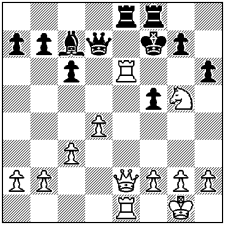
Of
course, if hxg5, then White proceeded with Qh5+, and the pawn could not
interpose, on account of Qh7 mate, while otherwise Black's rook was also
lost.
23.
Rxe8 hxg5 24. Qc4+ Qd5 25. Qxd5+ cxd5 26. g3 Bd6 27. R1e6 Kf7 28. Rxf8+
Resigns.
Bxf8 is his best, but then White must win easily with the exchange and a
pawn ahead.
Sources:
The International Chess Magazine, December 1885, page 369 (notes by
Wilhelm Steinitz*); The Birmingham
Weekly Mercury, June 28, 1890.
Two
years followed in which no blindfold exhibitions occurred at the City of
London Chess Club. Instead, Blackburne had performances at the new
established British Chess Club. His next appearance at the City Club (Salutation
Inn) was on October 8, 1888.
The
details of this meeting are:10
|
Result
+5 =3 -0; score 81.3 percent; playing hours 6.00 p.m.
— 11.30 p.m.
|
|
Opponents:
|
|
1
|
Blackburne
— Ridpath
|
½-½
|
|
5
|
Blackburne
— Smith
|
1-0
|
|
2
|
Blackburne
— Miller
|
1-0
|
|
6
|
Blackburne
— Bechhöfer
|
1-0
|
|
3
|
Blackburne
— Serraillier
|
½-½
|
|
7
|
Blackburne
— Hill
|
½-½
|
|
4
|
Blackburne
— Newman
|
1-0
|
|
8
|
Blackburne
— Swale
|
1-0
|
An
extensive account of the evening appeared in The International Chess Magazine (November 1888, pages 331-332):
There
was a great gathering of Chess masters to witness the performance such
as Herr von Bardeleben and Messrs Gunsberg, Lee, Pollock and Mortimer;
whilst the amateurs also mustered in force including Messrs. Gastineau,
Heppell, Hooke, Knight, Jamieson and Stevens. Mr. F.W. Lord acted as
"teller" for which office I think he "holds the field" against
the world. I may also mention that the presence of the fair sex was not
wanting on the occasion. Mr. Blackburne was again in fine form, and his
play was one of the most spirited character, and it was a treat to the
bystanders to see the way he conducted some of the more intricate parts
of the games. His opponents had been carefully selected from the third
team of the club and were mostly veterans, cool, steady and stubborn;
dangerous foes in one sense, as having considerable knowledge of match
play and possessing that steadiness under fire which is the mark of old
service under the flag; yet in another sense worthy foes, as having
themselves Chess ideas, they would be the more likely to evoke all the
genius of the blindfold player. Play commenced at 6 o'clock and Mr.
Blackburne opened at all the boards by 1 P-K4 to which 6 of his
opponents replied by a similar move, two only electing to go in for
irregular openings. The first nine moves all round were played
remarkably fast, and not more than three-quarters of an hour was
expended over them. By this time, of course, complications began to
appear in most of the games and Mr. Blackburne took some time over his
next series of four moves. At the end of these moves Mr. Blackburne had
taken up the running on most of the boards, and right and left he was
preparing attacks more or less promising. At Board No. 6 he got a
specially good game with a fine attack. This he pushed in really
splendid form, and at length gave up the Queen, forcing thereby the game
in beautiful style. This he did at 8:45 amidst loud applause, and then
he took half an hour's rest. On resuming play he soon made it warm all
round, but especially at Board No. 2 where he sent up his pawns on the
Kings flank and broke through in fine and dashing manner to the evident
of Herr von Bardeleben who was watching this game with great interest.
Mr. Blackburne soon had a won game here, but Mr. Miller, full of fight,
struggled on till after 11 before resigning. Victory followed the flag
of the "old bull-dog" right along the line, and at 11:30 the score
was Blackburne 5, drawn 2, and 1 unfinished and very drawish. Both
opponents agreed to draw and the encounter ended with Blackburne 5,
drawn 3, lost 0, and long and loud was the applause that followed the
announcement of the result.
One
game of the 1888 gathering has been found.
Joseph
H. Blackburne — Miller
1.
e4 e5 2. Nf3 Nc6 3. Bc4 h6 4. d4 d6 5. dxe5 Bg4 6. 0—0
Mr.
Blackburne intended playing for an old favorite (Legalle's) mate, and
should have played 6. Nc3, if Nxe5, 7. Nxe5 Bxd1 8. Bxf7+ Ke7 9. Nd5,
mate.
6.
... Nxe5 7. Be2 Bxf3 8. gxf3 Nf6 9. Nc3 c6 10. Kh1
Nothing
daunted by having missed his way to a direct attack in the opening, the
blindfold player builds up his game with a view to future events.
10.
... Qc7 11. Rg1 0—0—0
Castling
on the king's side, of course, cannot be effected.
12.
f4 Ned7 13. Be3 Kb8 14. a4 Ka8
Rather
than waste time thus he should strike out on his own account by pawn to
d5, or pawn to g5.
15.
Bf3 Nc5 16. b4 Ne6 17. a5 Qb8
To
guard against Bb6.
18.
Na4
Threatening
to win the queen by Nb6+.
18.
... Nd7 19. Nb6+ Nxb6 20. axb6 a6 21. f5 Ng5
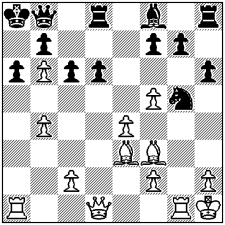
22. b5
Beautifully
played, and very accurately worked out.
22.
... Nxf3
If
cxb5, 23. Qd5 Qc8, mate follows in four moves.
23.
bxc6 bxc6
If
Nxg1, 24. c7 Qc8 25. Rxa6+ bxa6 26. Qd5+, and mates next move.
24.
Rxa6+ Kb7 25. Qa1
Clearly
perceiving that winning the queen would lead to very little more besides.
25.
... Kc8 26. Ra8 Rd7 27. Qa6+ Rb7 28. Ra1
The
coup juste. Black is defenseless. Resigns.
Source:
Leeds
Mercury,
October
13, 1888 (notes by James White).
The
Chess Monthly
(December 1888, page 124) offered the ending of this game, though with a
wrong diagram and a different move order.
A
small
anecdote involving Blackburne's blindfold play - and perhaps one of the
most appealing - was given in The Illustrated Sporting and Dramatic
News of November 22, 1879:
About ten
days ago he gave a "blindfold" performance at Cheadle, in
Staffordshire, which was remarkable in more respects than one. This town
or village is a small place, containing between three and four thousand
inhabitants, yet it managed to muster ten strong payers, who stood up,
or rather sat down, to uphold the honour of their native place. The
games lasted for several hours, mainly owing to Mr. Blackburne's
courtesy in not counting the time, and then the combatants being obliged
to vacate the room, where they were playing, and Mr. Blackburne's
opponents being very desirous of finishing all the games that same
evening, they proposed an adjournment to a school-room which was kindly
placed at their disposal by the vicar of the parish. To this proposal
Mr. Blackburne, who never shirks work, nor fails to oblige his opponents,
when he can do so, acceded. Then, with a torch-bearer at their head, the
whole company sallied, through the unlamped streets, armed with their
boards and the pieces theron in position. Slowly they moved to their
destination; but on their arrival there they discovered that several
pieces had been msiplaced by the jolting they encountered on the way,
and to get the rght positions it was proposed to play over the games
from the records that had been kept. Thereupon Mr. Blackburne offered to
save them that trouble by calling out the moves that had already been
made from the commencement on the several boards where the pieces had
been disturbed. This he did at once with great rapidity and perfect
correctness. Play was then resumed, and resulted in seven victories and
three "draws" to the champion. Chairing the conqueror was then
contemplated, but owing to the lateness of the hour was ultimately
abandoned. Great excitement prevailed that evening, nor did it terminate
with the night; indeed, it culminated next morning in a perfect furore.
For when the following day Mr. Blackburne went into a shop to make some
small purchase, the proprietor thereof with great glee informed him that
he had in the forenoon sold all the chess-boards and men in his
possession — numbering over one dozen.
This
story was more or less confirmed in a letter which was published in The
Times (October 27, 1890), eleven years afterwards. "An old
chessplayer", from Belper, Derbyshire, recalled (the number of
players in his story is in conflict with the account above):
"Some
years ago I was one of eight unfortunate players pitted against Mr.
Blackburne, he playing the whole of us simutaneously blindfold. The
meeting was held at an hotel in Cheadle, Straffordshire.
At
closing time, 11 o'clock, it was found that all the games were
unfinished, and, Mr. Blackburne being willing to continue, the players
carried their boards and men to a neighbouring school-room. Perhaps such
a
procession
had never been seen before. In the course of transit many of the
chessmen were displaced, and the different players were much troubled to
ascertain their correct positions. Mr. Blackburne, being informed of the
difficulty, offered to call out, blindfold, each game up to the point
when we left the hotel. This he did, and in every instance was correct."
Not
fully in line with the two above stories is the report of the meeting in
Land and Water (November 15, 1879). This paper did not mention
the late walk from the hotel to the school, and offered different details.
At
ten o'clock p.m. there was an adjournment for refreshments, but the
interruption does not seem to have affected Mr. Blackburne unfavourable,
for soon after coming back he announced a decisive advantage in six
moves against Dr. Yates, who thereupon resigned. Further on he announced
mate in seven moves against Mr. Beardmore, going through several
variations of play, some of which involved sacrifices.
The
blindfold exhibition took place at the Royal Oak Hotel on November 6,
1879. Blackburne's opponents were Orde , Davis, Yates, Askew, Beach,
Beardmore, Collier, Cotton, Cull and Peaty. Orde, Beach and Cotton drew
their games.11
Back
to the
picture. The artist was Horace Morchen, who frequently worked for The
Illustrated Sporting and Dramatic News.
----------
ADDITION:
Gerard Killoran (Ilkley, England) forwarded the following missing game of
Blackburne’s 1885 exhibition at the City of London Chess Club.
Joseph
H. Blackburne – George E. Wainwright
- City of London Chess Club, Blindfold
Exhibition
- London,
October 16, 1885
- C47 Four Knights’ Game
1. e4
e5 2. Nf3 Nc6 3. d4 exd4 4. Nxd4 Nf6
Good!
This avoids the danger resulting from the usual defense 4. Bc4, and is
good judgment on Black's part, for no one knows this gambit better than
Mr. Blackburne.
5.
Nc3 Bb4 6. Nxc6 bxc6 7. Bd3 Qe7 8. 0–0 0–0 9. Bg5 Qe5 10. Bxf6
White
naturally simplifies matters; for considering he has seven other games on
hand, it would not do to complicate things against a player of Mr.
Wainwright's strength. Otherwise 10. f4 seems to have points.
10.
... Qxf6 11. Ne2 d5
Very
properly declining the pawn offered him.
12.
Ng3 Rb8
Motto
- "Seize the open file."
13.
c3 Bc5 14. Qc2
Good;
but Black is too old a player to be caught with this kind of "chaff."
14.
... Kh8 15. Rae1
Probably
15. Rfe1 would have been better.
15.
... Bd7 16. e5 Qf4 17. Bf5 Bxf5 18. Nxf5 g6 19. Ng3 Rfe8 20. Qe2 Bd6 21.
Qa6 Rxb2
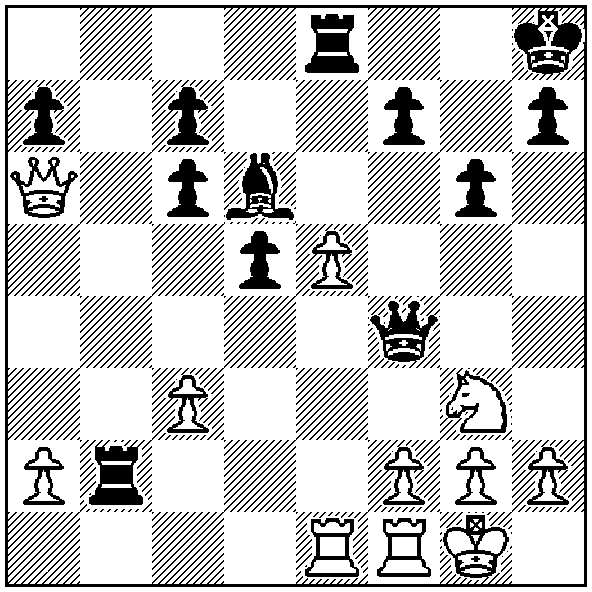
A
very fine move, and in high style. If 22. exd6 Rxe1 23. Rxe1 Qxf2+, and
mates next move.
22.
Qxc6 Rxe5 23. Rxe5 Qxe5 24. a4 h5
Threatening
pawn to h4 to win the knight.
25.
h4 Rc2 26. Rd1 Rxc3 27. Qxd5 Qxd5 28. Rxd5 Rc4 29. a5 Rxh4 30. Ne2 Re4 31.
Kf1 Re5 32. Rxe5 Bxe5 33. Ke1 Bd6 34. a6 Kg7 35. Nd4 Bc5 36. Nc6 Kf6 37.
f3 Ke6 38. Ke2 Kd5 39. Nd8 f6 40. Kd3 Be7 41. Nf7 Kc6 42. Kc4 g5 43. Nh6
Bd6 44. Nf5 Kb6 45. Kd5 Kxa6,
and
after a few more moves White resigned.
Source: The Hackney Mercury and North London Herald, November 7, 1885 (annotator
is unknown*).
----------
* The diagram was
given in the original source.
----------
Notes:
1 Daily News, September 17, 1889; The Illustrated
Sporting and Dramatic News, September 21, 1889; Leeds Mercury,
September 21, 1889. 2 Daily News, September
17, 1889. 3 The Chess Monthly, October 1882,
page 38. 4 The Standard, September 28, 1882; The
Field, September 30, 1882;
The Chess Monthly, October 1882, page 38. 5 The
Standard, September 28, 1882. 6 The Morning
Post, October 11, 1883; The Field, October 13, 1883; Land
and Water, October 20, 1883; The Illustrated London News,
October 20, 1883. 7 The Illustrated Sporting and
Dramatic News, October 24, 1885. 8 The
International Chess Magazine,
November 1885, page 324.
9 The
Morning Post,
October 19, 1885; The Illustrated
Sporting and Dramatic News, October 24, 1885; The
Chess Monthly, November 1885, page 66; The
International Chess Magazine, November 1885, page 324. 10
The Standard, October 9, 1888; Illustrated
Sporting and Dramatic News, October 13, 1888; British
Chess Magazine, November 1888, pages 436-437; Daily
News, October 9, 1888; The
Morning Post, October 15, 1888; The
Chess Monthly, November 1888, page 69. 11 Land
and Water, November
15, 1879.
----------
Pictures:
A Blindfold Chess Contest by Mr. Blackburne (The Illustrated Sporting
and Dramatic News, September 28, 1889); Alexander S. Beaumont (The
Chess Monthly, December 1893); Benjamin G. Laws (The Chess
Monthly, September 1892).
©
November 2016 Joost van Winsen. All Rights Reserved
ADDITION ©
January 2017 Joost van Winsen. All Rights Reserved
|
